#journal of landscape architecture
Text
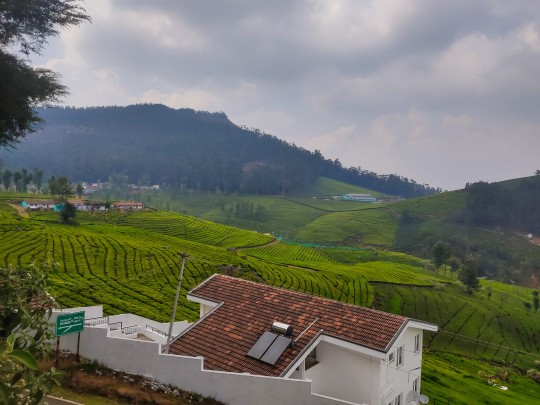
Nilgiris
#phone photography#nature lovers#lensblr#india#nature#nature photography#beautiful places#aesthetic#original photographers#photographers on tumblr#architecture#house#naturecore#nature blog#natureblr#original photography#my photography#photography blog#photography#nilgiris#mountain life#mountains#mountain landscape#landscape#hills#beautiful#travel journal#travel#explore#tea plantation
63 notes
·
View notes
Text

Тёплые лучи мягко ложатся на каменные стены домов, напоминая им и людям вокруг, что счастье это просто. Я учусь видеть красоту в чём-то простом и, казалось бы, заурядном. Ведь искусственно созданная красота, эстетика не позволяют порой пораскинуть мозгами и попытаться найти то, что зацепит взгляд или тронет душу. Обычно дают всё готовенькое. Красивые углы, правильно подобранный цвет. Смотря так на красивый дизайн, эстетично построенное здание с множеством разноцветных стёкол, я начинаю чувствовать себя избалованным ребёнком. Этому ребёнку ничего не нужно, кроме готовенького, прямо указывающее на красоту. Однако точно такая же, а порой и лучше, красота окружает каждого из нас. Кроется она то в листочке, то в ясном небе, а то и в простом солнечном луче, что как дорожка ложится на холодную поверхность, словно освещая путь.
Красота бывает разной. Специально «выструганная» и естественная. Однако цель у красоты одна — дарить наслаждение и радость, в каком-то роде даже удовлетворение. Порой не стоит ходить в специализированные места, чтобы найти красоту. Достаточно просто посмотреть на вещи под другим углом.
#notes#organized#study#photographers on tumblr#painting#photography#study aesthetic#study motivation#canon rebel#landscape#art#artists on tumblr#architecture#beautiful photos#original photographers#photoblog#photographer#оригинальные#русский блог#мой блог#эстетика#aesthetic#закат#здание#дневник#journal#beauty
38 notes
·
View notes
Text

he said "nice camera" - academy st, jsq, jc, nj - canon demi c & 400 film - developed at eliz digital & scanned with minolta dimage dual iii
#35mm#people#buildings#journal square#jersey city#new jersey#canon#canon photography#city street#architecture#modern architecture#film photography#film#35mm photography#35mm color photography#city#city photography#urban landscape#lensblr#brick
41 notes
·
View notes
Text

some night in new york x
#picturediary#beautiful#archives#pretty#nyc#skyline#new york#travel journal#nyc photography#nyclife#night sky#starry night#starry sky#empire state building#pretty lights#landscape#architecture#manhattan#architectdesign#travel#travel photography#art#design#artists on tumblr#photographers on tumblr#photography#aesthetic#fall aesthetic
10 notes
·
View notes
Text

The towers of San Gimignano. 🇮🇹 (Mixed media on paper)📓
#bell tower#medieval art#medieval architecture#medieval city#san gimignano#Florence#florence italy#italian landscape#italian language#plein air painting#plein air#study abroad#leaning tower of pisa#firenze#travel journal#travel diary#europe travel#travel italy#italy travel#italy trip#towers#tuscany#italian art#italian architecture#italian#roman architecture#roman art#gouache#gouache painting#art commissions 2023
23 notes
·
View notes
Text









the old man and the sea
#artists on tumblr#original photographers#urban photography#cityscape#city aesthetic#city photography#urban landscape#urban exploring photography#aesthetic blog#street photography#architecture photography#minimalism#minimalistic#travel photography#photographers on tumblr#visual storytelling#visual diary#visual poetry#visual journal#symmetry#serenity
6 notes
·
View notes
Text
Hi,
recently i tried to pay more attention to what surrounds me. As i’m walking down the street, as i’m crossing the road, as i wait at the bus stop.
I look around. I look down and up.
And i want to focus here on the “looking up”. I think we don’t usually look at what’s above us. We mostly see what’s on our eye level.

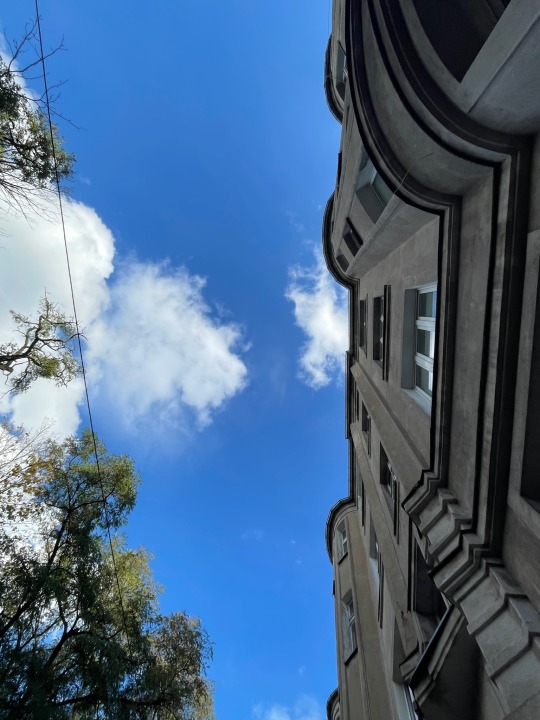
But as i was walking back to my dorm - the weather sunny, music playing in my headphones, gentle breeze on my skin - i looked up. I looked up next to this sad-looking building, it’s condition is bad as you can see in the photo, but it has its charm. I mean it’s architecture.
Looking up i actually saw the shape of the building, how tall it stands. How the shape draws the lines in the sky. How it was nice looking at it. So nice i took a photo.
Yes. I am that person - i see it, i like it, i want a photo of it, and i got a photo of it.
Shameless, that’s what i am in those situations. (And that’s also why my gallery is full and i have to buy space on icloud+)
I want to encourage you to look up. On your way home, on your way to work, school, grocery store - whatever is may be (just a walk is great) - look up, and then, take a photo of what you see.
Life suddenly is more interesting. Funny that.
Sending kisses.
PS. If you happen to do the photo. Send it to me, or comment it. I would love to see what you can see when you look up.
#see what’s up
#study blog#university#adventure#student#student life#wrocław#wroclove#journal#journaling#look up#see what’s up#architecture#landscape architecture#thoughts#my thougts#seriously though#see the sky#life#study life#college life#life quotes#daily life#deep thoughts#deep thinking
1 note
·
View note
Text
Light August winds :: a childhood story of prospect and refuge
The light August wind sways and rocks us in the chaise lounge limbs of the tree in which we sit. We are in the top limbs now, having spent the summer here in this huge old cherry tree, immersed in some sort of quest to eat all of her fruit.
Our visits had begun in June before the cherries were ripe. We went to the tree every day in hopes that the fruit was ready, that we could ascend and begin.…

View On WordPress
0 notes
Text
Headcanon Crafts for Everyone I Missed Last Time:
Idril: a sculptor. She worked with every kind of stone imaginable, and often went looking for new material in Gondolin’s mines with Maeglin. (Look my Maeglin head canons are complicated but they should get to be friends the narrative has hurt them too much already) She actually preferred not to make elvish figures, instead focusing on strangely beautiful stone landscapes and various animal-like figures. She was actually responsible for Middle-Earth’s version of the gargoyle, having carved several to stand guard over Gondolin. Several elves swore that the statues moved, but she never addressed those rumors. She also liked to paint her work with bright colors, which would’ve been seen as odd back in Valinor, but fit right in in First Age Middle-Earth.
Maeglin: a smith, but his craft was more in-line with Avarin practice than Noldor practice; with much less focus on the idea of making gems and heavier focus on understanding natural geology and the properties of various gems and metals. He knew the mines of Gondolin better than anyone, and wrote plenty about the the earth under the earth. His work also had fairly significant Dwarfish influences. He liked to make mechanically complex pieces, with moving parts or even some internal gear work.
Finduilas: a hunter. Her and her father were both nature people, just in very different ways. She was silent, with all the grace of a dancer, and quick enough to outrun most of what she hunted. She preferred to go after more aggressive animals– wild boar, wolves, bears, even wargs– and leave the deer and rabbits be. She was born in Beleriand, and had never met the Valar, but sometimes, privately, offered up prayers to Orome. She liked to imagine she could’ve been in his hunt, if things had turned out a bit differently.
Celebrimbor: a smith, in the very traditional Noldor sense. Gemworker, specialized in jewelry, made various famously beautiful pieces, etc. Was never quite happy sticking to hairpins and necklaces. Longed to try his hand at imbuing his work with real power, but always talked himself out of it. A whole binder of concepts for works of power sat locked away in a chest in his workshop for centuries. He never talked to anyone about it. He was as ashamed of his feelings for his craft as he was of his feelings for his family. By the end of his life, he’d made peace with only one of those things.
Earendil: a mariner? Alright, he was definitely a mariner, and he loved the ship life– he even built a few boats of his own, in a similar fantastic style to Turgon’s architecture– but he also had a longstanding fascination with the natural world, and filled volumes and volumes of journals with information on various plants, animals, and minerals. But natural lore isn’t a recognized Noldor craft, since it involves learning but doesn’t really produce tangible results. Still, it was a passion he got from afternoons spent learning about geology with “Uncle Mole,” and one he shared with Elrond. Researching the beauty and wonder of nature gave Earendil something to do with his immortal life, and was a big part of the reason Elrond chose to be immortal at all.
Gil-Galad: a king. No, really, he’d been the high-king of the Noldor since he was a child, and hadn’t really had time for trivialities like “finding a life purpose” or “having fun.” He was too busy learning how to stay alive in late stage Beleriand (read: hell) and learning to rule the least cooperative group of elves imaginable. He wanted to be a painter, and while he found enough practice time to get good at his chosen craft; because of how long detailed paintings can take, he almost never had time to actually make anything. He tried not to let it bother him too much. He didn’t always succeed at that.
Elrond: in a bit of a weird spot. Elrond is most associated with lore and healing; but, as discussed, “lore” isn’t considered a craft. And, well. Healing had to be Elrond’s craft, right? He’d been doing it since he was seven, and just about the only person in Amon Ereb who could still use healing powers. And it was good work, and it was rewarding, even if it often left him feeling so burned out and worried that he forgot to eat or sleep. It took him a long time to admit to himself that healing for him was what fighting was to many other elves: a necessity. Truth be told, he’d rather be gardener, working with the earth to create a place of peace and beauty. Also, Elrond is basically a nature spirit. So. It was something he began to explore in the peace of the early Second Age. He found that his Ainuric powers had all sorts of interesting effects on plant life. He also learned how to breed new varieties of fruits, vegetables, and flowers. Still, he never really considered that it could be a proper craft for him. At least, not until he first saw the valley that would one day become Rivendell.
Headcanon Crafts for Finwe and his Children, the House of Feanor, the House of Fingolfin, and the House of Finarfin.
#silmarillion#silm headcanons#house of finwe#noldor#noldor crafts#idril#maeglin#finduilas#celebrimbor#earendil#gil galad#elrond#elrond peredhel#eldritch peredhel#I have feelings about elrond and gil galad#they had to grow up so fast#they deserve peace
123 notes
·
View notes
Text
Random strawhat headcannons because I can:
Luffy: He seems so dumb until you ask him about beetles. He's a bug enthusiast. Thinks Buggy doesn't deserve the name bc actual bugs are WAY cooler. Tone deaf.
Zoro: Genuinely likes to hear about history and culture, he just gets the geography mixed up. I bet he has shoulder pains but just doesn't say anything. Has an appreciation for art, just doesn't feel like putting time towards developing the skill. Also Tone deaf.
Nami: Likes drawing quite a bit, and in her free time she doodles the landscapes she sees. Farsighted but her eyesight isn't too bad.
Usopp: IDGAF what Oda says he's a lefty in my book. Favorite medium is watercolor, but enjoys charcoal drawing too. Wants to get a tattoo to be cool but is too afraid it'll hurt too bad.
Sanji: tone deaf. Cannot hold a tune to save his life.
Chopper: doesn't even bother telling Zoro off about his bad habits anymore. He knows he'll never listen. Wants to learn how to draw (it'll help him with his medical journals), and spends time with Usopp and Nami to learn.
Robin: She enjoys some shenaniganery too. She very easily sneaks up on everyone else to spook them. On top of general history, she also admires architecture. She and Franky nerd out about it.
Franky: how his ginormous hands play an average sized guitar is beyond me, but I bet he has regular jam sessions with Brook.
Brook: You hand this man ANY instrument and he already has previously mastered it, or will in a matter of minutes. The skeleton jokes are a coping mechanism. Enjoys when anyone else joins in on his musical endeavors.
Jinbe: (I'm about to start the Marine Ford arc, I'm in impel down right now, at the part where everyone is trying to escape to go save Ace, so fair warning if he's mischaracterized, I'm going off what I've seen in clips and little in-show material) Gives the best hugs out of anyone else. Amazing at comforting others without sugarcoating much.
BONUS ROUND
Bon Clay: Typically not the violent type until push comes to shove, or until there's a new pair of pointe shoes that need to be broken in. I mean this guy is so violent with the pointe shoes. I know they need to be broken in and fitted right but damn what did the shoe do to you?
Buggy: He starts rehearsing different circus acts when he's stressed out. Like "Captain!" "What?" "What are you doing?" "I'M WALKING A TIGHTROPE THAT'S AS UNSTABLE AS ME RIGHT NOW!"
#one piece#buggy the clown#one piece nami#cat burglar nami#nami#luffy#monkey d. luffy#roronoa zoro#vinsmoke sanji#usopp#chopper#tony tony chopper#nico robin#franky#franky one piece#soul king brook#brook#one piece jinbe#jinbe#jinbei#first son of the sea jinbe#bon clay
110 notes
·
View notes
Note
Am I right in suspecting that GPT-4 is not nearly as great an advance on GPT-3 as GPT-3 was on GPT-2? It seems a much better product, but that product seems to have as its selling point not vastly improved text-prediction, but multi-modality.
No one outside of OpenAI really knows how much of an advance GPT-4 is, or isn't.
When GPT-3 came out, OpenAI was still a research company, like DeepMind.
Before there was a GPT-3 product, there was a GPT-3 paper. And it was a long, serious, academic-style paper. It described, in a lot of detail, how they created and evaluated the model.
The paper was an act of scientific communication. A report on a new experiment written for a research audience, intended primarily to transmit information to that audience. It wanted to show you what they had done, so you could understand it, even if you weren't there at the time. And it wanted to convince you of various claims about the model's properties.
I don't know if they submitted it to any conferences or journals (IIRC I think they did, but only later on?). But if they did, they could have, and it wouldn't seem out of place in those venues.
Now, OpenAI is fully a product company.
As far as I know, they have entirely stopped releasing academic-style papers. The last major one was the DALLE-2 one, I think. (ChatGPT didn't get one.)
What OpenAI does now is make products. The release yesterday was a product release, not a scientific announcement.
In some cases, as with GPT-4, they may accompany their product releases with things that look superficially like scientific papers.
But the GPT-4 "technical report" is not a serious scientific paper. A cynic might categorize it as "advertising."
More charitably, perhaps it's an honest attempt to communicate as much as possible to the world about their new model, given a new set of internally defined constraints motivated by business and/or AI safety concerns. But if so, those constraints mean they can't really say much at all -- not in a way that meets the ordinary standards of evidence for scientific work.
Their report says, right at the start, that it will contain no information about what the model actually is, besides the stuff that would already be obvious:
GPT-4 is a Transformer-style model [33 ] pre-trained to predict the next token in a document, using both publicly available data (such as internet data) and data licensed from third-party providers. [note that this really only says "we trained on some data, not all of which was public" -nost] The model was then fine-tuned using Reinforcement Learning from Human Feedback (RLHF) [34 ]. Given both the competitive landscape and the safety implications of large-scale models like GPT-4, this report contains no further details about the architecture (including model size), hardware, training compute, dataset construction, training method, or similar.
As Eleuther's Eric Hallahan put it yesterday:

If we read further into the report, we find a number of impressive-looking evaluations.
But they are mostly novel ones, not done before on earlier LMs. The methodology is presented in a spotty and casual manner, clearly not interested in promoting independent reproductions (and possibly even with the intent of discouraging them).
Even the little information that is available in the report is enough to cast serious doubt on the overall trustworthiness of that information. Some of it violates simple common sense:

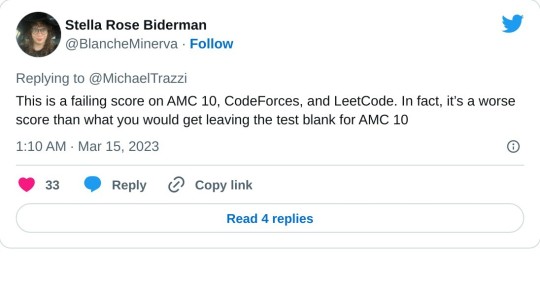
...and, to the careful independent eye, immediately suggests some very worrying possibilities:

That said -- soon enough, we will be able to interact with this model via an API.
And once that happens, I'm sure independent researchers committed to open source and open information will step in and assess GPT-4 seriously and scientifically -- filling the gap left by OpenAI's increasingly "product-y" communication style.
Just as they've done before. The open source / open information community in this area is very capable, very thoughtful, and very fast. (They're where Stable Diffusion came from, to pick just one well-known example.)
----
When the GPT-3 paper came out, I wrote a post titled "gpt-3: a disappointing paper." I stand by the title, in the specific sense that I meant it, but I was well aware that I was taking a contrarian, almost trollish pose. Most people found the GPT-3 paper far from "disappointing," and I understand why.
But "GPT-4: a disappointing paper" isn't a contrarian pose. It was -- as far as I can see -- the immediate and overwhelming consensus of the ML community.
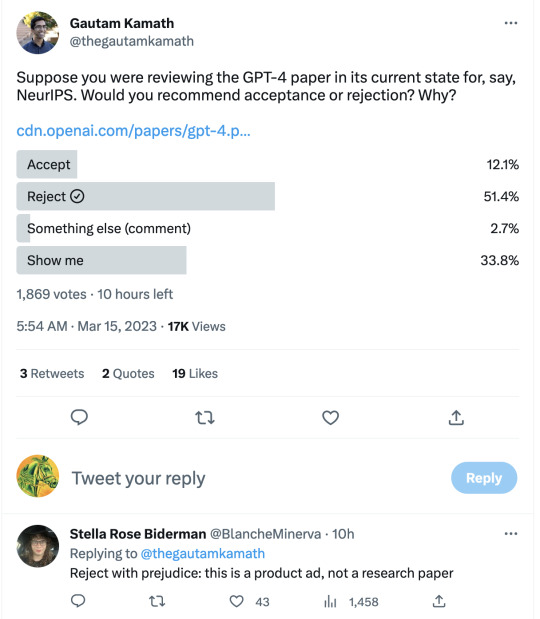
----
As for the multimodal stuff, uh, time will tell? We can't use it yet, so it's hard to know how good it is.
What they showed off in the live demo felt a lot like what @nostalgebraist-autoresponder has been able to do for years now.
Like, yeah, GPT-4 is better at it, but it's not a fundamentally new advance, it's been possible for a while. And people have done versions of it, eg Flamingo and PaLI and Magma [which Frank uses a version of internally] and CoCa [which I'm planning to use in Frank, once I get a chance to re-tune everything for it].
I do think it's a potentially transformative capability, specifically because it will let the model natively "see" a much larger fraction of the available information on web pages, and thus enable "action transformer" applications a la what Adept is doing.
But again, only time will tell whether these applications are really going to work, and for what, and whether GPT-4 is good enough for that purpose -- and whether you even need it, when other text/image language models are already out there and are being rapidly developed.
#ai tag#gpt-4#ugh i apparently can't respond to npf asks in the legacy editor :(#the npf/beta editor is still painful to use#it's nice to be able to embed tweets though
388 notes
·
View notes
Text



David Rios Ferreira’s new permanent artwork “Landscapes adrift— cosmically woven and earthly bonded” at 7 Av (F,G) station in Brooklyn incorporates elements of science-fiction, the natural world, architecture, and history across approximately 700 square feet of glass mosaic. Inspired by the station's proximity to Prospect Park, Ferreira drew inspiration from the snapping turtles and red-eared sliders that inhabit the park. These turtles hold significance in creation stories shared by Indigenous peoples such as the Lenape and those of the Northeastern Woodlands, as well as in Hindu and Chinese mythologies, where the earth is believed to be carried on the back of a giant turtle. Building upon this narrative and drawing from his own Taino heritage (the Indigenous people of the Caribbean), Ferreira's artwork seeks to bridge present-day concepts of home with a shared cultural connection to the planet across time.
Ferreira's mosaics feature amalgamations of abstract and representational images of turtles, drawing from a variety of interpretations found in scientific journals and Indigenous cultures. These images intertwine with recontextualized depictions of neighborhood maps, buildings, landmarks, and plants. The vibrant backgrounds of the mosaics utilize iridescent glass, creating a captivating shimmering effect reminiscent of swirling algae in lakes, while also evoking a sense of the otherworldly and cosmic. Ferreira's artwork takes viewers on a fantastical journey that mirrors the experience of commuters traveling through the station.
📸: Pedro A. Estevez
32 notes
·
View notes
Text

jsq path station jc, nj - yashica mg-1 & 100 iso e-6 color slide film - developed at bleecker digital & scanned with minolta dimage dual iii
#35mm#train station#journal square#jersey city#new jersey#slide film#construction#people#infrastructure#architecture#modern architecture#modern art#35mm photography#35mm color photography#film photography#city#city photography#urban landscape#street photography#lensblr
6 notes
·
View notes
Text

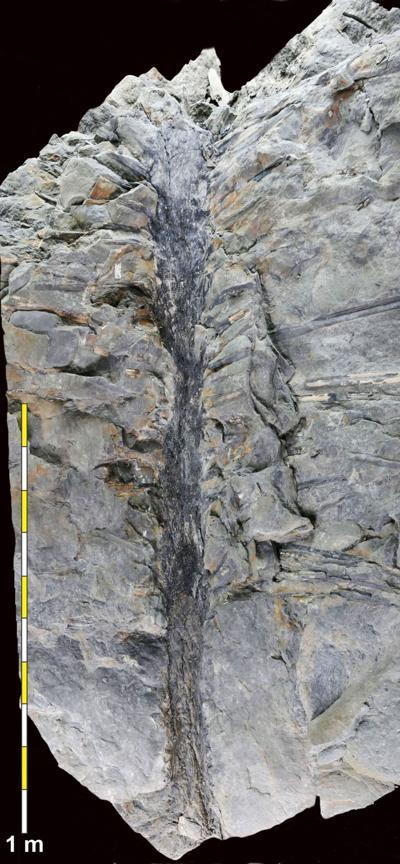
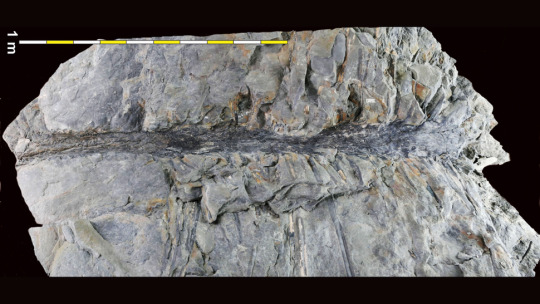
Rare 350 Million-Year-Old Tree Fossils Has Scientists ‘Gobsmacked’
Rare tree fossils preserved with their leaves have an architecture unlike any plant known today and represent the earliest evidence of smaller trees growing beneath the forest canopy.
Trees are believed to have originated hundreds of millions of years ago. Ever since, evidence of these ancient plant sentinels has been in short supply.
Now, a new discovery of uniquely 3D tree fossils has opened a window into what the world was like when the planet’s early forests were beginning to evolve, expanding our understanding of the architecture of trees throughout Earth’s history.
Five tree fossils buried alive by an earthquake 350 million years ago were found in a quarry in the Canadian province of New Brunswick, according to a study published Friday in the journal Current Biology. The authors said these new and unusual fossil trees not only bear a surprising shape reminiscent of a Dr. Seuss illustration, they reveal clues about a period of life on Earth of which we know little.
“They are time capsules,” said Robert Gastaldo, a paleontologist and sedimentologist who led the study, “literally little windows into deep-time landscapes and ecosystems.”
Coauthors Olivia King and Matthew Stimson unearthed the first of the ancient trees in 2017 while doing fieldwork in a rock quarry in New Brunswick. One of the specimens they discovered is among a handful of cases in the entire plant fossil record — spanning more than 400 million years — in which a tree’s branches and crown leaves are still attached to its trunk.
Few tree fossils that date back to Earth’s earliest forests have ever been found, according to Gastaldo. Their discovery helps fill in some missing pieces of an incomplete fossil record.
“There are only five or six trees that we can document, at least in the Paleozoic, that were preserved with its crown intact,” said Gastaldo, a professor of geology at Colby College in Waterville, Maine.
Most ancient tree specimens are relatively small, he noted, and often discovered in the form of a fossilized trunk with a stump or root system attached. For his colleagues to find a preserved tree that could have been 15 feet tall in its maturity with an 18-foot diameter crown left the paleontologist “gobsmacked.”


Ancient earthquake burial
The researchers excavated the first fossil tree about seven years ago, but it took another few years before four more specimens of the same plant were found in close proximity to one another. Dubbed “Sanfordiacaulis,” the newly identified species was named in honor of Laurie Sanford, the owner of the quarry where the trees were unearthed.
The forms taken by these previously unknown 350 million-year-old plants look somewhat like a modern-day fern or palm, per the study, despite the fact that those tree species didn’t appear until 300 million years later. But while the tops of ferns or palms as we know them boast few leaves, the most complete specimen of the newly discovered fossils has more than 250 leaves preserved around its trunk, with each partially preserved leaf extending around 5.7 feet (1.7 meters).
That fossil is encased in a sandstone boulder and roughly the size of a small car, according to Stimson, an assistant curator of geology and paleontology at the New Brunswick Museum.
The unique fossilization of the cluster of trees is likely due to a “catastrophic” earthquake-induced landslide that took place in an ancient rift lake, he said.
“These trees were alive when the earthquake happened. They were buried very quickly, very rapidly after that, at the bottom of the lake, and then the lake (went) back to normal,” Stimson said.
Finding complete fossil trees is rare and much less common than finding a complete dinosaur, according to Peter Wilf, a professor of geosciences and paleobotanist at Pennsylvania State University who was not involved with the study. Wilf noted via email that the “unusual” new fossil tree was a relic of a time period from which there are almost no tree fossils.
“The new fossils are a milestone in our understanding of how early forest structure evolved, eventually leading to the complex rainforest architectures that support most of Earth’s living biodiversity,” Wilf added.

‘Very Dr. Seuss’
To King, a research associate at the New Brunswick Museum who found the group of fossils, the Sanfordiacaulis would have looked like something plucked straight out of Dr. Seuss’ most popular works.
“You know in ‘The Lorax,’ the trees have these big pom-poms at the top and narrow trunks? These probably have a similar structure. You have this massive crown at the top, and then it does narrow and paper into this very small trunk,” King said. “It’s a very Dr. Seuss-looking tree. It’s a weird and wonderful idea of what this thing could look like.”
But the reign of the Sanfordiacaulis was short-lived, the researchers said. “We do not see this architecture of plant again,” Stimson said. He noted that it grew in the early Carboniferous, a time period at the end of the Paleozoic Era when plants and animals were diversifying as they started to make their way from water to land.
Much of evolution is experimental, with success often measured by a species’ versatility, or ability to adapt to many different places and conditions. The peculiar set of tree fossils presents proof of a “failed experiment of science and evolution,” Stimson added. “We’re really starting to paint that picture as to what life was like 350 million years ago.”
Looking forward
Fossils such as the Sanfordiacaulis are not just useful in helping humans understand how life changed in the past, they can help scientists figure out where life on our planet might be headed next.
The existence of this particular species suggests that trees of the period were starting to occupy different ecological niches beyond what was previously understood, according to the researchers behind its discovery.
Gastaldo sees this as an indication that plants — much like early invertebrates — were experimenting with how they adapted to the environment. The earthquake that likely led to the trees’ fossilization also offers new geological evidence of what may have been occurring in Earth’s systems at the same moment in time.
“This is really the first evidence we have of (a tree) that would be between what grows on the ground and what would tower way above the ground,” Gastaldo said. “What else was there?”
By Ayurella Horn-Muller.

#Rare 350 Million-Year-Old Tree Fossils Has Scientists ‘Gobsmacked’#New Brunswick#Fossils#Tree Fossils#paleontologist#sedimentologist#geology#Sanfordiacaulis#archeology#archeolgst#history#history news#ancient history#long post#long reads
26 notes
·
View notes
Text
"In the summer of this year we made a journey to Transylvania, and went over the old ground which was, and is, to us so full of vivid and terrible memories. It was almost impossible to believe that the things which we had seen with our own eyes and heard with our own ears were living truths. Every trace of all that had been was blotted out. The castle stood as before, reared high above a waste of desolation."
We thought about what would happen with these memories of Transylvania after Jonathan, and Mina went back to England without looking behind to that place which was holding their most painful moments.
Would they be able to go back? Would the written memories of Jonathan trapped inside the castle be too painful? Would Mina want to see again that spot where our brave cowboy died? Could the snow have washed his blood away?
And the answer is that they went back, and saw how nature all around has erased all of the traces of the Count's doing. Centuries, and centuries of terror wiped out by the hands of nature. The chase, the marks of the horses on the ground, the final blow against an undead monster, the gallant sacrifice for two people he knew, and the light reflecting on a stainless forehead. All of it flew away like sand on the beach.
Mina, and Jonathan saw, felt, and experienced the impossible. They went to places they probably thought will never see, interacted with people they never thought to meet in their lifetime, went to hell and back. Yet... the only thing left of that grand, and hellish moment is the castle. The only thing that can tell them "Yes, it happened, and it was real" is still there, but utterly changed.
The castle became another relic of Transylvania. What was once a source of terror, and evil became another example of the obsolete power of lords past, and now it's a wonder of ancient architecture. Maybe in the future someone will go there, and study what is inside to record it for history.
But today, seven years later, Mina and Jonathan realized that just like them, nature moved fowards, and that time doesn't stop for anyone.
This whole adventure may have passed like a breath in the land of Transylvania, now forgotten by the beautiful landscapes, and the wolves. However, maybe Mina can breath a sight of quiet peace as she watches the sun, and Jonathan can take her hand and show her all of the things he saw before, just like he promised, and wrote on may in his travels journal.
#It's such a poetic touch#And even if the castle is still there#It's just a castle today#dracula daily#dracula#mina harker#mina murray#jonathan harker
52 notes
·
View notes
Text




"home is where all your attempts to escape cease" checkout is at 12h
#artists on tumblr#original photographers#aesthetic photography#artistic photography#urban photography#symmetry#travel photography#aesthetic blog#urbanexploration#urban landscape#architecture photography#photographers on tumblr#visual poetry#visual storytelling#visual diary#visual journal#cozy aesthetic#cityexploration#city aesthetic#city photography#cityscape#streetphotography#street photography#art gallery#minimalstyle#minimal aesthetic#minimal photography#artisticexpression#muted tones#travelphotography
2 notes
·
View notes